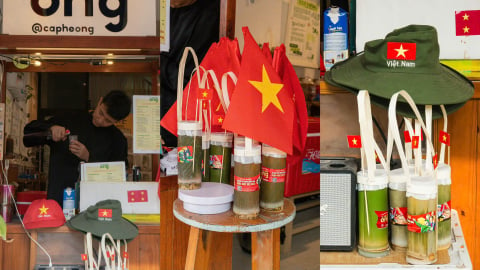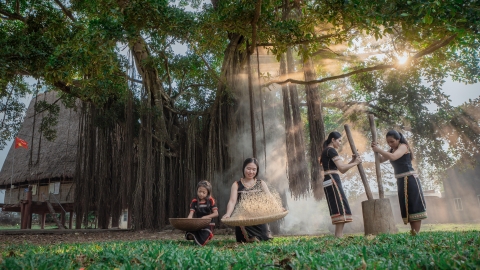Stepping through the doors of the World Coffee Museum, I felt like I was stepping into a memory. The space was both open and had something that urged people to go deeper inside, to listen to the story of the coffee bean - a small bean that has changed the land and the life of the people of the Central Highlands.


The World Coffee Museum is a place that opens up memories of coffee around the world.
Museum architecture with strong Central Highlands imprint
The first impression that struck me was not the smell of roasted coffee, nor the glittering artifacts behind the glass, but the building itself. The museum’s architecture was inspired by the Ede longhouse, with its curved roof and its shell covered with silent basalt blocks. From afar, I saw it as a giant lithophone embedded in the red soil of Buon Ma Thuot, both solid and soft.

The architecture of the World Coffee Museum is inspired by the typical long house of the Ede people in Buon Ma Thuot.

The glass door opened, a cool breeze blew through, carrying the musty scent of wood and moss, mixed with the scent of coffee wafting from a nearby cafe. I suddenly felt like I had crossed the boundary between everyday life and a distant memory.
Inside, natural light streamed through the gaps in the ceiling, through the transparent umbrellas, making the space feel more open, the high roof created a sacred feeling like standing in a coffee temple. I heard my footsteps echoing softly on the wooden floor, each step seemed to lead me back in time.


Light-filled space in the museum
In the lobby, I was introduced to the world's famous coffee cultures, the lands of coffee beans across continents on a glass map. Then, with just a turn, the vestiges of the Central Highlands culture such as the H'gor drum (buffalo skin drum) of the Ede people, gongs, terracotta products, agricultural tools, musical instruments... opened before my eyes a unique culture of Vietnam, both familiar and new.

Map of the homeland of coffee beans in the world
A Journey into the Past - From Coffee Plants to a Civilization
The first exhibition area took me back to the history of coffee in the world. Ceramic pots, mills, and teapots from many cultures appeared one after another under the warm yellow light. I stopped in front of an ancient pot from Ethiopia, the homeland of coffee plants, then admired the sophisticated yet mysterious copper pots from Turkey. From the ancient European roasters to the familiar aluminum filter of Vietnam, each artifact seemed like a slice of history, telling the story of the journey of coffee beans traveling thousands of miles to become a global drink.




Experience with Turkish sand coffee model
I paused for a long time in front of the old cast iron roaster, touching the rough surface stained by time. I imagined that in the past, the smoke from here must have filled the entire street corner. There were precious books displayed in glass cabinets, meticulously recording the cultivation process, the journey of bringing coffee from one plateau to another. The lines reminded me that coffee was never just a crop, but a small civilization.


Exhibition area of coffee roasters that have appeared in the world
The history of coffee is associated with the cultural identity of the Central Highlands.
After walking through the world of coffee, I stopped at the Central Highlands culture exhibition area. There, gongs were lined up, the light was tilted, each pattern engraved on the bronze seemed to glow. There were also folk musical instruments: T'rung, Khen, drums, each instrument seemed to contain the sound of wind, stream, and human heart. Next to them were traditional costumes with brocade patterns. I closed my eyes, imagining the sound of gongs resounding in the festival, resonating with the sound of drums and Khen, harmonizing with the sacred rhythm of the mountains and forests.



Exhibition area of gongs and musical instruments of the Central Highlands culture
I stopped in front of a special display corner, where familiar farming tools such as hoes, knives, baskets, and baskets woven from rattan and bamboo worn by time were displayed. Placed next to the coffee artifacts, they seemed to remind me that every coffee bean has gone through the hands of labor, that the sweet flavor in today’s cup of coffee is the crystallization of sweat and perseverance. I touched the rough bamboo surface, feeling like I was touching the hard-working memories of countless people who had carried the coffee season over the mountain passes and slopes.



The cultural exhibition area made me realize that the museum not only preserves the history of coffee but also embraces the soul of the Central Highlands. Coffee here is not simply an agricultural product, but a bond that connects villages, music, beliefs and life.
The last taste of coffee
Leaving the exhibition space, I walked into the cafe located right in the museum. The aroma was overwhelming, passionate and warm, embracing all my senses. I ordered a cup of filter coffee, sat by the wide open glass window overlooking the lush green garden. The coffee drops fell slowly, each dripping sound reminded me of the journey I had just taken: from ancient artifacts, cultural stories to the rich aroma of the present.



There are several areas in the museum that serve free coffee to visitors.
The cup of coffee was bitter on the tip of my tongue, but the aftertaste was sweet and lingered for a long time. I took a sip, closed my eyes, and imagined the journey the coffee beans had taken before ending up in the small cup before me.
Leaving the museum, I stepped out into the sun of Buon Me Thuot, the highland wind blew, carrying the scent of moist soil and the chirping of birds. In my mind, the image of the silent gongs, the old roasting machine, the book lying quietly on the shelf still lingered. I realized that the museum was not only a place for exhibitions, but also a place where I found a rhythm of connection - between the past and the present, between the mountains and forests of the Central Highlands and sips of coffee every morning.



The museum is a place that brings a connection - between the past and the present through the story of coffee beans.
The World Coffee Museum tells the story not only of the coffee bean, but also of the people and culture that nurture it. It was that aftertaste that lingered most deeply in my mind when I left.

 EN
EN



































